
PREV ARTICLE
NEXT ARTICLE
FULL ISSUE
PREV FULL ISSUE
COUNTERSTAMP RESEARCH: THE HALLMARKS OF THEOPHILUS BRADBURY
Tom Kays submitted this great write-up describing the results the Smartphone-powered numismatic research effort that took place over dinner Tuesday night among members of my numismatic social group, Nummis Nova.
-Editor
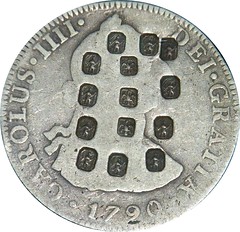
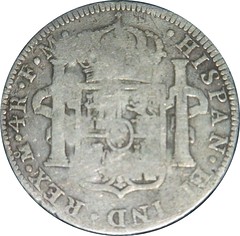
Rich Licato hosts a website for coins with Oriental chops in which he specializes. He brought an unusual coin to dinner with unknown counterstamps. A 1790 Mexican four reales, held three identical eagle stamps and eleven identical Native Americans stamps in array on the obverse. Sitting opposite Rich, Mike Packard immediately recognized the significance of the two symbols together as those used on Massachusetts coppers of 1787 and 1788. Each punch was small and raised within an octagon shape, like a rectangle with the corners clipped.

After thinking a bit Mike suggested that silversmiths might use such punches. Mike then mumbled "Theophilus Bradbury." We blessed him, and he said, that was no sneeze but the name of a Massachusetts silversmith he had come across in his study of Jacob Perkins, of Newburyport, Massachusetts, maker of steel printing plates for printing currency and engraver of the famous Washington Funeral Medals (Skull and Cross Bones as well as Urn motifs) used in Boston in 1800. A side conversation with Gene Brandenburg who was learning to use his new Android phone led us to consult the Internet on the spot. We found an image of his silver marks on a set of spoons. Theophilus Bradbury used an eagle punch, the letter "B" and a Native American punch said to be a mirror image of the Massachusetts symbols. The eagle punch with head right, is so distinctive we had a positive ID right there at dinner with but five minutes research. Theophilus Bradbury, (1763 – 1848) silversmith of Newburyport, partnered with Joseph Moulton (1744-1816), another eminent silversmith. Their shop "Moulton & Bradbury" was on Merrimack Street in Newburyport by 1796 where they made plated buckles. By 1815 Theophilus was in league with his son, Ebenezer as "Theophilus Bradbury & Son" making soup, sauce and cream ladles, table and tea spoons, sugar basins, tea pots, cream pots and pitchers. Jacob Perkins is said to have inspected Theophilus Bradbury & Son spoons in 1816 finding them equal to European manufacture. May we surmise Theophilus needed to test a new set of punches, perhaps to find the right amount of hammer pressure to raise a good image but not enough to damage a fine silver spoon? Taking a silver coin at hand he idly whacked it over a dozen times until satisfied, and then applied the punches to finish his product. Rich was thrilled to have such eminent provenance applied to his coin.

To visit the CyberAttic site, see: Set of 6 tsps by Theophilus Bradbury, Newburyport, Mass (www.cyberattic.com/stores/NorthHill/items/898096/en2cyberattic.html)
I was busy chowing down and talking at the other end of the table while this was going on, and missed much of the action. Tom filled me in after dinner, and kindly provided the above write-up and images. Numismatics is getting more fun every day!
I should note that the Native American punch is NOT that same as the one on Mike Packard's enigmatic coin illustrated earlier in The E-Sylum. That stamp is much larger, matches the Massachusetts symbol without mirror-imaging, and still unattributed. -Editor
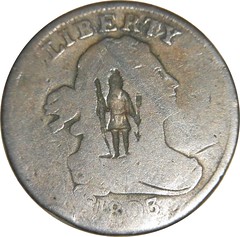
To read the earlier E-Sylum article, see: AN ENIGMATIC NATIVE AMERICAN COUNTERSTAMP (www.coinbooks.org/esylum_v14n26a16.html)
Tom Kays has a follow-up query for E-Sylum readers. Can anyone help? Thanks.
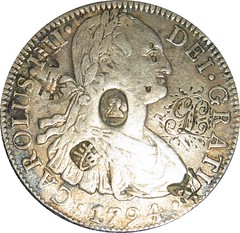
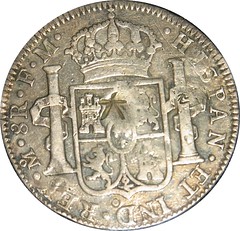
As an exercise for E-Sylum readers who unfortunately did not dine with us, we invite you to supply provenance for another of Rich's interesting chopped coins pictured above, a 1794 Mexican eight reales. Notice the King George III counterstamp at center, the engraved script initials "GL" with flourishes at 3:00 o'clock (a love token?), the unusual and exotic large punches, small, Type I chops, and blundered or damaged letters in the legend (see "REX" on the reverse for example). Starting at face value in Mexico City in 1794, or perhaps starting elsewhere if you believe this to be a counterfeit (e.g. Birmingham plate, New York forgery, 19th century Boston reproduction?), what is this coin's story? Begin sleuthing.
The Numismatic Bibliomania Society is a non-profit organization promoting numismatic literature. See our web site at coinbooks.org. To submit items for publication in The E-Sylum, write to the Editor at this address: whomren@gmail.com To subscribe go to: https://my.binhost.com/lists/listinfo/esylum All Rights Reserved. NBS Home Page Contact the NBS webmaster 
|